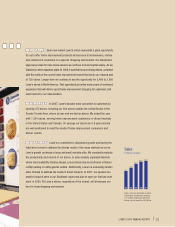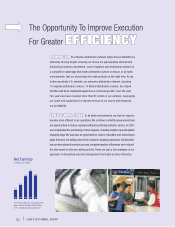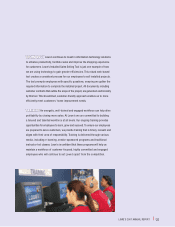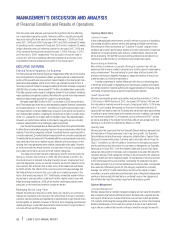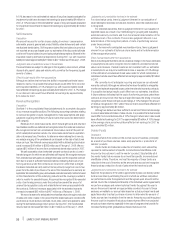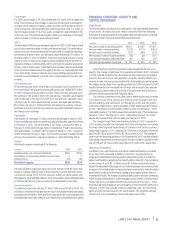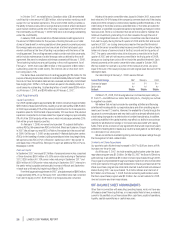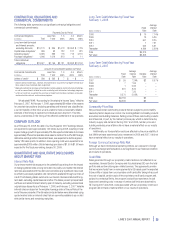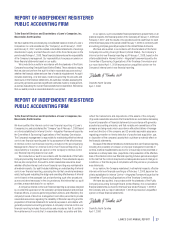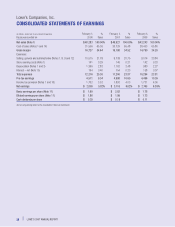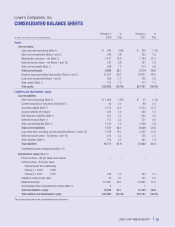Lowe's 2007 Annual Report Download - page 22
Download and view the complete annual report
Please find page 22 of the 2007 Lowe's annual report below. You can navigate through the pages in the report by either clicking on the pages listed below, or by using the keyword search tool below to find specific information within the annual report.20 |LOWE’S 2007 ANNUAL REPORT
A 10% decrease in the estimated fair values of long-lived assets evaluated for
impairment would have decreased net earnings by approximately $4 million for
2007.A 10% increase in the estimated fair values of long-lived assets evaluated
for impairment would have increased net earnings by approximately $3 million
for 2007.
Self-Insurance
Description
We are self-insured for certain losses relating to workers’ compensation,
automobile,property, general and product liability,extended warranty and certain
medical and dental claims.Self-insurance claims filed and claims incurred but
not reported are accrued based upon our estimates of the discounted ultimate
cost for self-insured claims incurred using actuarial assumptions followed in the
insurance industry and historical experience. During 2007, our self-insurance
liabilityincreasedapproximately$21millionto $671millionas ofFebruary1,2008.
Judgments and uncertainties involved in the estimate
These estimates are subject to changes in the regulatory environment,utilized
discount rate, payroll,sales and vehicle units,as well as the frequency, lag and
severity of claims.
Effect if actual results differ from assumptions
Although we believe that we have the ability to reasonably estimate losses
related to claims, it is possible that actual results could differ from recorded
self-insurance liabilities.A 10% change in our self-insurance liability would
have affected net earnings by approximately $42 million for 2007.A 1% change
in our discount rate would have affected net earnings by approximately
$10 million for 2007.
Revenue Recognition
Description
See Note 1 to the consolidated financial statements for a complete discussion
of our revenue recognition policies.The following accounting estimates relating
to revenue recognition require management to make assumptions and apply
judgment regarding the effects of future events that cannot be determined
with certainty.
Revenues from stored value cards, which include gift cards and returned
merchandise credits,are deferred and recognized when the cards are redeemed.
We recognize income from unredeemed stored value cards at the point at
which redemption becomes remote.Our stored value cards have no expiration
date or dormancy fees.Therefore,to determine when redemption is remote,
we analyze an aging of the unredeemed cards based on the date of last stored
value card use.The deferred revenue associated with outstanding stored value
cards increased $18 million to $385 million as of February 1, 2008.We rec-
ognized $15 million of income from unredeemed stored value cards in 2007.
We sell separately-priced extended warranty contracts under a Lowe’s-
branded program for which we are ultimately self-insured.We recognize revenues
from extended warranty sales on a straight-line basis over the respective contract
term due to a lack of sufficient historical evidence indicating that costs of per-
forming services under the contracts are incurred on other than a straight-
line basis. Extended warranty contract terms primarily range from one to four
years from the date of purchase or the end of the manufacturer’s warranty, as
applicable.We consistently group and evaluate extended warranty contracts based
on the characteristics of the underlying products and the coverage provided in
order to monitor for expected losses.A loss would be recognized if the expected
costs of performing services under the contracts exceeded the amount of
unamortized acquisition costs and related deferred revenue associated with
the contracts. Deferred revenues associated with the extended warranty
contracts increased $92 million to $407 million as of February 1,2008.
We record a reserve for anticipated merchandise returns through a reduction
of sales and costs of sales in the period that the related sales are recorded.We
use historical return levels to estimate return rates, which are applied to sales
during the estimated average return period. During 2007,the merchandise
returns reserve decreased $4 million to $51 million as of February 1, 2008.
Judgments and uncertainties involved in the estimate
For stored value cards, there is judgment inherent in our evaluation of
when redemption becomes remote and, therefore,when the related income
is recognized.
For extended warranties, there is judgment inherent in our evaluation of
expected losses as a result of our methodology for grouping and evaluating
extended warranty contracts and from the actuarial determination of the
estimated cost of the contracts. There is also judgment inherent in our
determination of the recognition pattern of costs of performing services
under these contracts.
For the reserve for anticipated merchandise returns, there is judgment
inherent in our estimate of historical return levels and in the determination
of the average return period.
Effect if actual results differ from assumptions
We do not anticipate that there will be a material change in the future estimates
or assumptions we use to recognize income related to unredeemed stored
value cards. However, if actual results are not consistent with our estimates
or assumptions, we may incur additional income or expense.A 10% change
in the estimate of unredeemed stored value cards for which redemption is
considered remote would have affected net earnings by approximately $3 million
in 2007.
We currently do not anticipate incurring any losses on our extended
warranty contracts.Although we believe that we have the ability to adequately
monitor and estimate expected losses under the extended warranty contracts,
it is possible that actual results could differ from our estimates. In addition,
if future evidence indicates that the costs of performing services under these
contracts are incurred on other than a straight-line basis,the timing of revenue
recognition under these contracts could change.A 10% change in the amount
of revenue recognized in 2007 under these contracts would have affected net
earnings by approximately $5 million.
Although we believe we have sufficient current and historical knowledge
to record reasonable estimates of sales returns,it is possible that actual returns
could differ from recorded amounts.A 10% change in actual return rates would
have affected net earnings for 2007 by approximately $3 million.A 10% change
in the average return period would have affected net earnings for 2007 by
approximately $2 million.
Vendor Funds
Description
We receive funds from vendors in the normal course of business,principally
as a result of purchase volumes, sales, early payments or promotions of
vendors’ products.
Vendor funds are treated as a reduction of inventory cost, unless they
represent a reimbursement of specific, incremental and identifiable costs
incurred by the customer to sell the vendor’s product. Substantially all of
the vendor funds that we receive do not meet the specific, incremental and
identifiable criteria.Therefore, we treat the majority of these funds as a
reduction in the cost of inventory as the amounts are accrued and recognize
these funds as a reduction of cost of sales when the inventory is sold.
Judgments and uncertainties involved in the estimate
Based on the provisions of the vendor agreements in place, we develop vendor
fund accrual rates by estimating the point at which we will have completed
our performance under the agreement and the agreed-upon amounts will be
earned.Due to the complexity and diversity of the individual vendor agreements,
we perform analyses and review historical trends throughout the year to
ensure the amounts earned are appropriately recorded. As a part of these
analyses, we validate our accrual rates based on actual purchase trends and
apply those rates to actual purchase volumes to determine the amount of
funds accrued and receivable from the vendor.Amounts accrued throughout
the year could be impacted if actual purchase volumes differ from projected
annual purchase volumes,especially in the case of programs that provide for
increased funding when graduated purchase volumes are met.



